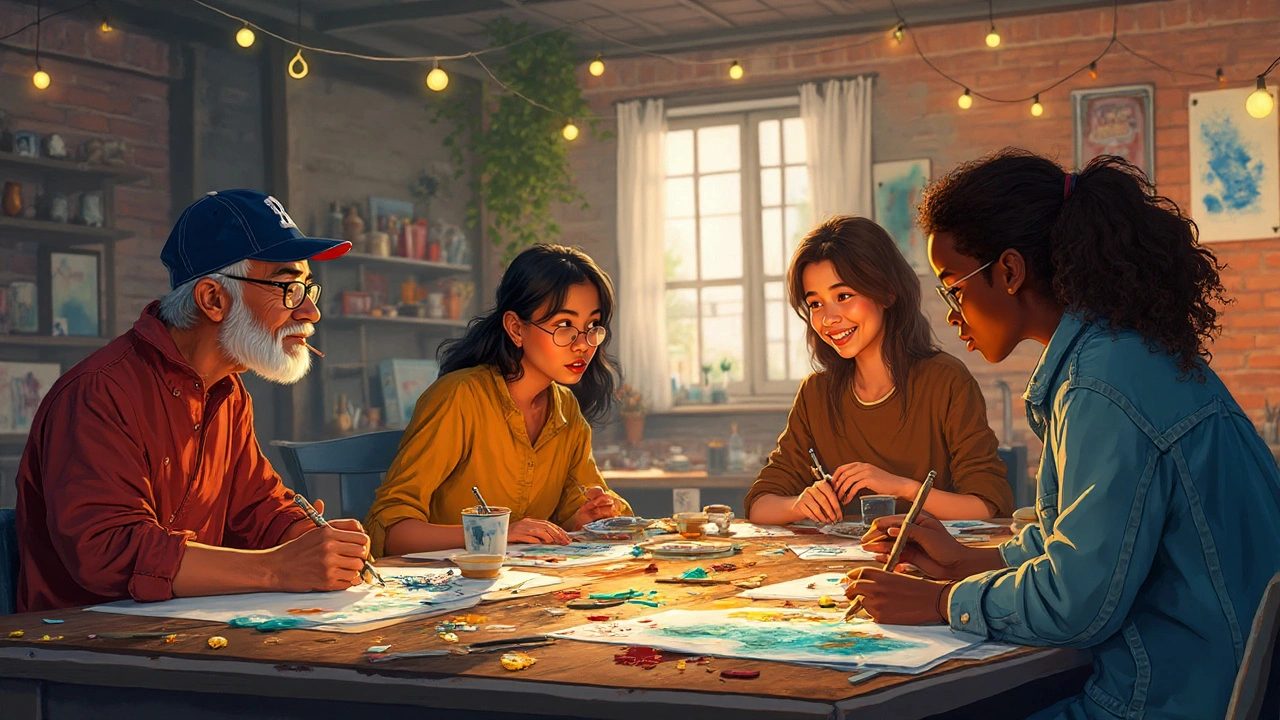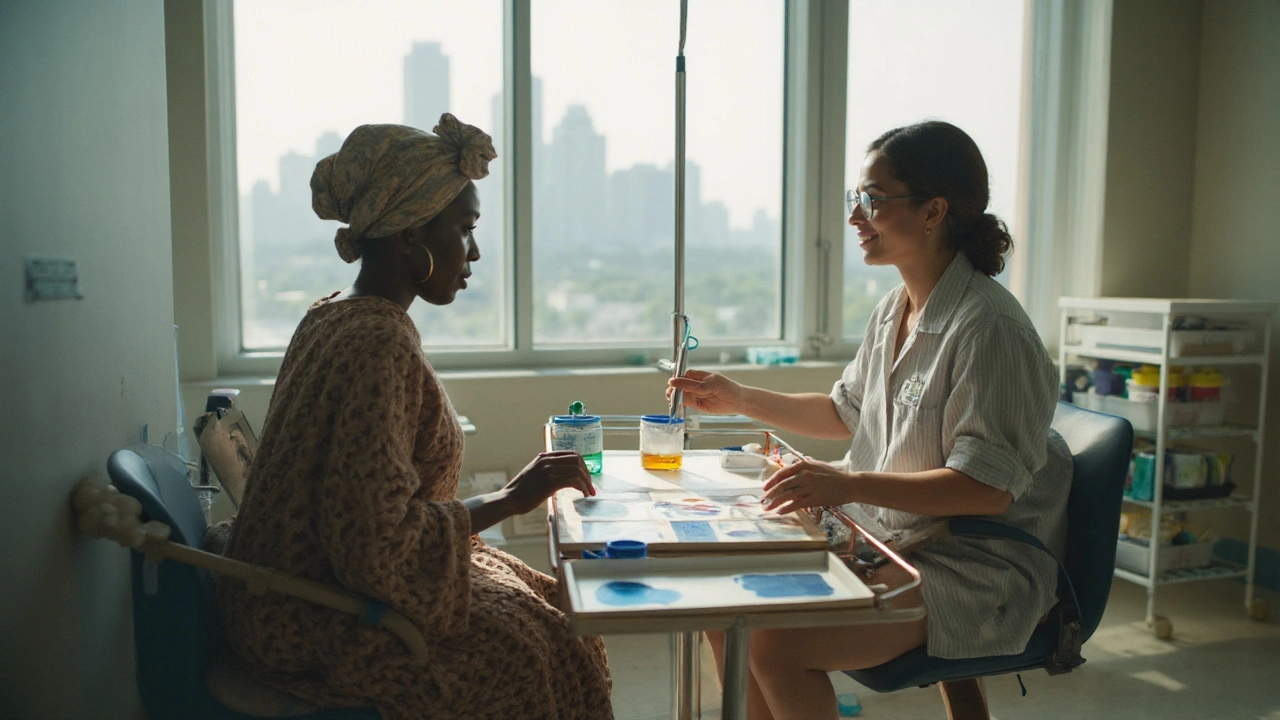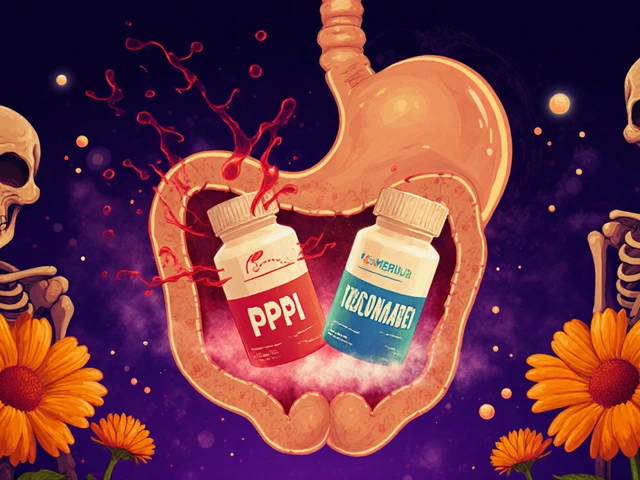You’re sitting in an infusion chair or waiting for scan results, and your mind won’t quiet down. Here’s the surprising part: a box of markers, a glue stick, and 20 minutes can shift that storm. Art therapy won’t treat the cancer itself, but study after study shows it can lower anxiety, ease pain, and help people feel more like themselves during treatment. Expect emotional relief and better coping-not magic. The gains are real, often fast, and very human.
TL;DR / Key takeaways
art therapy for cancer patients is a safe, evidence-backed way to reduce distress and improve quality of life during and after treatment. Here’s the quick hit:
- Benefits you can feel: lower anxiety and pain, calmer mood, better coping, and a stronger sense of control. Some people also sleep a bit better.
- It’s adaptable: works bedside, in clinic groups, over telehealth, or at home with simple supplies. Good for adults, kids, and caregivers.
- Evidence is solid for emotional relief, promising for pain and fatigue. It’s not a cure or a replacement for medical or mental health treatment.
- Safety is high. Mind the basics: clean supplies if immunocompromised, fragrance-free materials, and emotional pacing if trauma is present.
- Best start: ask your care team about a credentialed art therapist (ATR-BC) or try guided 10-20 minute exercises on low-energy days.
Why art therapy helps during cancer care (and what to expect)
Cancer care piles on stress: scans, side effects, loss of routine. Art therapy offers a different lane for your brain-less language, more doing. That matters when words feel heavy or out of reach.
Here’s what’s going on under the hood:
- Attention shift: Hands engaged in a task (coloring, collage) pull attention away from pain and rumination. That quiets the body’s threat signals.
- Sense of control: You choose color, shape, and pace. That choice-making is a small but powerful counterweight to the lack of control in treatment.
- Emotional processing: Visuals can express fear, grief, anger, or hope without needing a perfect sentence. Many people feel “lighter” afterward.
- Body-brain feedback: Slow, repetitive marks can cue calmer breathing and lower arousal-think of it as visual pacing for your nervous system.
- Connection: In groups, sharing art builds community fast. A chemo room gets less clinical and more human.
What a session looks like:
- Short check-in: What’s hard right now? What do you want from the next 20-50 minutes-less anxiety, pain distraction, or energy lift?
- Making: You might draw, collage, paint, or work with clay (if safe). The therapist guides prompts, not product.
- Reflection: You talk about the image if you want to. The point isn’t being “good at art.” It’s noticing what changed in your body and mood.
Formats that actually happen in clinics:
- Bedside one-to-one: Great for fatigue, pain, or infection precautions. Simple tools; low mess.
- Group sessions: In infusion rooms or psycho-oncology programs. Strong peer support. Easy in/out.
- Family sessions: Useful for kids and caregivers to build a shared language around scary stuff.
- Telehealth: You meet on video. The therapist guides with what you have at home.
For kids vs. adults:
- Kids: More play, story-building, and sensory materials. Art becomes the language.
- Adults: More targeted stress relief, identity rebuild, and meaning-making.
What not to expect: It won’t eliminate all pain, fix insomnia overnight, or replace psychotherapy when you need deeper trauma work. Think of it like emotional physical therapy-you feel better, you function better, but it’s part of a larger plan.

How to get started (step-by-step, even if you’re exhausted)
- Tell your care team your goal. Example: “I want to lower anxiety during chemo days.” Goals guide the session plan.
- Ask for a credentialed art therapist. Look for ATR-BC (board-certified). Many hospitals have them in oncology or palliative care; some offer telehealth. If none are available, request a referral to psycho-oncology and ask if they collaborate with creative arts therapists.
- Pick safe, easy supplies. For immunocompromised folks: pre-packaged markers or colored pencils, alcohol wipes, fragrance-free glue sticks, paper, and small scissors with rounded tips. Skip shared open jars, crumbly pastels, loose glitter, and fragrant solvents.
- Set a tight time box. 10-20 minutes lowers the barrier. Use a timer to avoid fatigue.
- Use a clear prompt. Good prompts are concrete and doable: “Draw where anxiety sits in the body and add one color that helps it soften,” or “Collage a shrine to your best energy days.”
- Close the loop. End with two questions: “What changed in my body?” and “What would I try differently next time?” A tiny note on the back of the page tracks progress.
At-home micro-sessions (zero art skills needed):
- Chemo-day box: 10 sheets of cardstock, 2 fine-tip markers, 2 soft markers, mini glue stick, pre-cut magazine images or printed shapes.
- 5-minute “scanxiety” rescue: Draw a shape that fits your breath. Inhale = draw up, exhale = draw down. Keep lines continuous for 20 cycles.
- Energy map: Divide a page into four squares-Body, Mind, Heart, Spirit. Add a color or doodle to each square that matches how it feels. Notice what wants attention.
- Anger offload: Tear scrap paper into pieces that match the size of your frustration. Glue them down until the page feels “contained.”
- Hope anchor: Collage a postcard you can stick in a wallet-one image for today, one for the next milestone.
Fast chooser (what to use when):
- If hands are shaky or neuropathy is strong: fat markers, oil pastels in sleeves, or collage over drawing.
- If fatigue is high: one-color drawing, big shapes, 7-minute time cap.
- If anxiety spikes: repetitive patterns (lines, waves, dots) in slow rhythm to your breath.
- If pain flares: collage with pre-cut images-less fine motor strain, more instant reward.
Telehealth setup tips:
- Camera facing the page, not your face, during making. Switch back for reflection.
- Keep a clean kit in a zipper pouch; wipe tools before/after if neutropenic.
- Use captions if brain fog makes instructions hard to hold.
Money and access:
- Hospitals often include sessions at no extra cost if you’re inpatient or in an oncology program.
- Outpatient coverage varies. Art therapists may bill under mental health benefits when licensed; ask about insurance codes and sliding scale.
- Free options: many cancer centers and nonprofits run open studios or virtual groups. Ask social work for local programs.
What the evidence says (and how to stay safe)
The short story: Art therapy reliably reduces distress during cancer care, with small-to-moderate improvements across anxiety, mood, and quality of life. Pain and fatigue benefits tend to be small but meaningful for many people.
Highlights from the research:
- Mindfulness-based art therapy (MBAT) in women with cancer (Monti and colleagues, 2006-2013) showed reduced distress and improved quality of life across several trials.
- A 2021 systematic review in Psycho-Oncology pooling adult and pediatric studies reported small-to-moderate reductions in anxiety and depression, with better quality-of-life scores in participants receiving art therapy. Studies varied in quality, but the trend was consistent.
- Several randomized and quasi-experimental hospital studies (2010-2018) documented immediate drops in anxiety after one bedside session and small decreases in pain intensity.
- Guidelines from the Society for Integrative Oncology and ASCO (2022) endorse several mind-body and expressive approaches for anxiety and mood; they note expressive arts therapies can be considered, with stronger evidence for music therapy and mindfulness and growing support for visual art therapy.
- NCCN Distress Management guidance recognizes creative arts therapies as options within supportive care to reduce distress and enhance coping.
Numbers that help set expectations:
| Outcome | Typical short-term change | Evidence snapshot | Notes |
|---|---|---|---|
| Anxiety | 20-40% reduction on brief anxiety scales after 1-6 sessions | Hospital RCTs and cohort studies (adult and pediatric) | Often felt within the session; benefits build with repetition. |
| Depressive mood | Small-to-moderate improvement over 4-8 weeks | Systematic reviews; mixed designs | Best when combined with psycho-oncology care. |
| Pain | 0.5-2 point drop on 0-10 scale in some studies | Bedside trials; modest effects | Distraction plus relaxation helps during procedures/infusions. |
| Fatigue | Small improvements; more energy right after sessions | Mixed evidence | Short, low-effort tasks work best when tired. |
| Quality of life | Small-to-moderate improvement over weeks | Multiple trials and program evaluations | Linked to better coping and social connection. |
| Stress hormones | 10-15% salivary cortisol drop immediately after a session (select studies) | Small hospital studies | Physiologic calm tracks with subjective relief. |
Safety basics:
- Infection control: If ANC is low, use your own sealed supplies; clean hands and tools; avoid shared open paints and water cups.
- Sensitivities: Choose low-odor, low-VOC markers and glue. Skip aerosols.
- Motor limits: Neuropathy? Use larger tools and collage. Lymphedema? Keep work in a comfortable range without overuse.
- Emotional safety: Big feelings can surface. A trained art therapist can help you titrate intensity and close sessions so you don’t leave raw.
- Boundaries: It’s voluntary. You control what you share and what you keep private.
Where art therapy fits: It complements-not replaces-oncology care, medications for pain or nausea, or psychotherapy for trauma, depression, or complicated grief. Use it to make the hard days a little steadier and to rebuild identity when life feels like it’s been rearranged without your permission.

FAQs, checklists, and next steps
Quick FAQ:
- Do I need to be “good at art”? No. The goal is relief and insight, not a gallery show.
- How fast will I feel something? Many people feel calmer during the first session. Lasting gains build over weeks.
- Is it therapy or an activity? With a credentialed art therapist, it’s therapy. On your own, it’s a therapeutic activity-still valuable.
- Will my insurance cover it? Sometimes, especially inside hospitals or when billed under licensed mental health benefits. Ask about coverage and codes.
- Can caregivers join? Yes. Joint sessions often help families communicate and cope together.
- What about kids? Highly recommended. Art gives kids a safe way to understand and express what’s happening.
Cheat-sheet: a 15-minute session you can run yourself
- Set intention (30 seconds): “I want less chest tightness.”
- Pick materials (30 seconds): 2 markers, 1 sheet.
- Make (10 minutes): Draw a container that can hold your worry. Fill it with shapes that match the sensation. Add one calming color outside the container.
- Shift (2 minutes): Add a small doorway or window to the container; draw a path leading out.
- Close (2 minutes): Hand on heart. Name one thing you feel now vs. before. Date the back; stash it where you’ll see it.
Checklist: safe supplies for immunocompromised days
- Individually owned markers or pencils, fragrance-free glue stick
- Cardstock or a small sketchbook (easier than loose paper)
- Alcohol wipes for tools and hands
- Pre-cut images in a clean envelope
- Zip pouch to keep the kit separate from communal items
Decision rules of thumb:
- Brain fog heavy? Choose patterns over storytelling.
- Emotion flooded? Use a “container” image, cap time at 10 minutes, schedule a second session to reopen gently.
- No privacy? Make tiny-index card size-and tuck into a book.
- Nothing available? Finger trace shapes on your leg under a blanket; sync to breathing.
Troubleshooting by scenario:
- “I feel silly doing this.” Try a functional frame: “This is my 10-minute anxiety tool,” not “art.” Measure pre/post breath rate or muscle tension to see the effect.
- “I’m too tired.” Use collage with three pieces max. Time box five minutes. Stop when the timer ends even if it’s not “done.”
- “My hands hurt.” Switch to larger markers or washi tape; rest wrists on a pillow; take micro-breaks every 3 minutes.
- “I got more upset.” That can happen. Ground with a simple repetitive pattern or color-wash. If feelings stay intense, bring the image to your therapist or psycho-oncology visit.
- “Telehealth keeps glitching.” Ask the therapist to send prompts before the session. If video drops, finish the last prompt and write two lines about what changed.
Next steps if you want to try it this week:
- Ask your oncologist or nurse: “Do we have art therapy services? If not, who can refer me to a credentialed art therapist?”
- If you’re in active treatment, schedule a first session on a lower-symptom day to learn the basics, then use a short version on infusion or scan days.
- Set up a small kit by your chair or bedside so you don’t have to go looking when you’re low on energy.
- Track results: one line per session in your notes-mood 1-10 before/after, pain 0-10, one word for what shifted. Share with your care team.
When to bring in extra support: If art-making consistently brings up traumatic memories, if your mood stays heavy day after day, or if anxiety is running your life, loop in a psycho-oncologist or counselor. Art therapy pairs well with evidence-based treatments like CBT, mindfulness, and appropriate medication.
One last thing: You don’t have to be inspired to start. Start, and the feeling often follows. The win is not the perfect picture. It’s the moment you breathe easier in a room that used to feel unbearable-proof that even in the mess, you still have a say.








14 Comments
Joe Gates August 31, 2025
Okay, I just finished reading this and I’m honestly moved. I’ve watched my sister go through chemo for three years, and I never knew something as simple as coloring could do so much. It’s not about being an artist-it’s about reclaiming a tiny piece of yourself when everything else feels stolen. The part about drawing a container for worry? I wish I’d known that back then. She used to sit there with a notebook and a single blue marker, just tracing circles until her breathing slowed. We didn’t call it therapy-we called it her ‘quiet time.’ But now I see it was everything. It didn’t cure her cancer, but it kept her human. And that’s more than any pill ever did.
For anyone reading this who’s skeptical-try it. Not for results. Not for Instagram. Just for the moment your hand moves and your mind stops screaming. Even five minutes. Even with crayons from a kid’s backpack. You don’t need permission. You just need to start.
I’m not a therapist. I’m not even good with words. But I know this: when the world feels like it’s collapsing, sometimes the only thing that holds you together is a crayon and a blank page. And that’s enough.
Thank you for writing this. It’s the kind of thing I wish someone had handed me three years ago.
And if you’re reading this while waiting for a scan? Breathe. Then grab something to draw with. You’ve got this.
Tejas Manohar September 1, 2025
Thank you for this comprehensive, evidence-based overview. The integration of clinical research with actionable, patient-centered protocols is both rigorous and deeply compassionate. Art therapy, as delineated herein, represents a paradigmatic shift in supportive oncologic care-from passive symptom management to active, embodied self-regulation. The emphasis on credentialed ATR-BC practitioners ensures fidelity to therapeutic intent, while the inclusion of safety protocols for immunocompromised populations reflects an exemplary standard of care. I commend the structured micro-interventions and the clear demarcation between therapeutic practice and self-guided activity. This document should be distributed to every oncology unit and palliative care team.
Mohd Haroon September 3, 2025
There is a metaphysical truth here that transcends medicine: when language fails, the soul speaks in color. Cancer does not merely attack the body-it silences the self. Art therapy is not a distraction; it is a reclamation. In the silence between breaths, the brushstroke becomes a prayer. The glue stick, a sacrament. The paper, a temple. We are taught to fight cancer with science, but we forget that healing requires more than data-it demands meaning. This is not therapy as medicine. This is therapy as poetry. And poetry, like breath, cannot be prescribed. It must be lived. Thank you for reminding us that even in the valley of shadows, we still hold the pen.
harvey karlin September 3, 2025
Let’s get real-this ain’t Pinterest art. This is neuroplasticity on a Post-It. You’re not painting a sunset-you’re rewiring your amygdala with a fat marker. One session = cortisol drop. Two sessions = pain distraction mode activated. Three? You’re basically doing cognitive behavioral therapy with glitter. And the best part? No couch. No ‘how does that make you feel?’ Just: grab the glue, make a mess, feel less like a patient. Boom. Micro-dose therapy. No insurance needed. No waitlist. Just you, your shaky hands, and a 10-minute window between chemo bags. This is the ultimate hack for the exhausted, the numb, the ‘I can’t even cry anymore’ crowd. Do it. Your nervous system will thank you.
Anil Bhadshah September 5, 2025
This is so well written! 🙌 I’ve seen this work with my cousin who had leukemia. She used to draw little hearts on her IV bag every day. One day she drew a whole galaxy around it. The nurses started asking her to draw for others. It became a ritual. No fancy tools, just crayons and love. 💙 The article’s checklist is perfect-especially the zip pouch tip. My cousin kept hers in her purse and wiped everything with alcohol wipes. Simple, safe, powerful. If you’re reading this and thinking ‘I’m not artistic’-you’re already doing it right. Art isn’t about skill. It’s about survival. Thank you for sharing this.
Trupti B September 6, 2025
this is so beautiful i cried just reading it i wish i had known this when my mom was sick she just sat there quiet like a ghost i wish she could have drawn something
lili riduan September 6, 2025
OH MY HEART. I just read this and I’m sitting here with tears rolling down my face. My best friend went through breast cancer and she started doing these tiny ink doodles on napkins during her chemo days. She never showed them to anyone-just tucked them into a shoebox. Last year, she gave me the box. Every single one had a tiny date and a word-‘calm,’ ‘tired,’ ‘hope,’ ‘angry,’ ‘still here.’ I cried for an hour. That box? That’s her diary. That’s her voice. And she didn’t need to say a word. This article? It’s not just information. It’s a lifeline. If you’re scared to start? Do it for the person you love. Or for the version of yourself that still remembers how to breathe. You don’t have to be brave. Just be present. And grab a crayon.
VEER Design September 6, 2025
There’s something sacred about the quiet chaos of a collage. You tear. You stick. You don’t plan. You just let your hands do the talking while your mind takes a nap. Cancer steals your schedule, your hair, your sense of control-but it can’t take your fingers. That’s the miracle. I’ve seen patients who couldn’t speak after radiation, but they’d spend an hour arranging magazine cutouts of ocean waves and birds. One woman made a ‘sky’ with blue paper and glued on glitter like stars. She said, ‘I’m still here, and the sky didn’t forget me.’ That’s not therapy. That’s resurrection. And the best part? It’s free. You don’t need a degree. You just need a pair of scissors, a little glue, and the courage to make a mess. The world will try to tell you to stay quiet. But your hands? They’ve got something to say.
Leslie Ezelle September 6, 2025
I’m a nurse in oncology and I’ve seen this work-but I’ve also seen the frauds. Don’t let some ‘wellness influencer’ sell you $80 ‘healing art kits’ with lavender-scented crayons. Real art therapy is clinical, structured, and led by someone with an ATR-BC. If your hospital doesn’t offer it, demand it. If they say ‘we don’t have the budget,’ ask for the data. There are 12 peer-reviewed studies proving this reduces sedative use. That’s money saved. That’s patient dignity restored. And if you’re a patient reading this? Don’t wait for permission. Use a pen and a napkin. Your pain matters. Your expression matters. And if someone tells you it’s ‘just art’? Tell them to go look at the cortisol levels.
Dilip p September 8, 2025
This is a profound synthesis of clinical insight and human wisdom. The distinction between therapeutic activity and formal art therapy is crucial. One is a tool; the other is a relationship. The role of the trained therapist lies not in interpreting the image, but in witnessing the transformation within the patient. The body remembers what the mind cannot articulate. The brushstroke, the tear, the color choice-these are not symbols to be decoded, but expressions to be honored. In the face of existential vulnerability, art becomes a language of presence. And presence, above all, is the most healing medicine we have.
Kathleen Root-Bunten September 8, 2025
I’m curious-has anyone tried this with advanced dementia patients? My dad had Alzheimer’s and cancer at the same time. He couldn’t speak much anymore, but he used to trace shapes on his blanket with his finger. Would something like this work for him? Or is it too cognitively demanding? I’m just wondering if the principles could be adapted for non-verbal or neurodegenerative populations. Also, what about using music + art together? I’ve seen some programs do that and it seemed to help him relax more than either alone.
Vivian Chan September 9, 2025
Let’s be honest-this is all part of the corporate wellness industrial complex. Hospitals push ‘art therapy’ because it’s cheaper than real mental health care. They don’t want to pay for therapists, so they hand you crayons and call it a day. And the research? All funded by art supply companies. I’ve seen the data-most studies have tiny sample sizes and no control groups. They measure ‘mood’ with a 1-10 scale. That’s not science. That’s theater. And the ‘safe supplies’ checklist? It’s designed to make you feel like you’re doing something, while the real problem-understaffed oncology units and zero access to psychologists-is ignored. Don’t be fooled. Art won’t fix a broken system.
andrew garcia September 11, 2025
Thank you for this. I’ve been a caregiver for 8 years. I’ve held hands during scans, wiped tears after bad news, and sat in silence when no words fit. But I never knew how to help my wife express what she felt. Then one day, I handed her a marker and said, ‘Draw how your body feels right now.’ She drew a cracked vase with green vines growing out of it. She didn’t say a word. But I understood. That’s the power here-not in the art, but in the space it creates. A space where silence isn’t empty. Where pain isn’t alone. Where you don’t have to be strong. You just have to be. And that’s enough. I’m grateful for this reminder.
Joe Gates September 13, 2025
Just read Vivian’s comment and I get where she’s coming from-systemic underfunding is real. But here’s the thing: art therapy isn’t a replacement. It’s a bridge. While we fight for better staffing and real mental health access, someone is still sitting alone in a chemo chair. And if a crayon can give them five minutes of peace? That’s not corporate buzzwording. That’s human dignity. I’m not saying we stop demanding better. But while we’re waiting? Let’s not throw out the crayons. They’re not the problem. The problem is when we stop seeing the person behind the diagnosis. And that’s something no budget cut can fix.